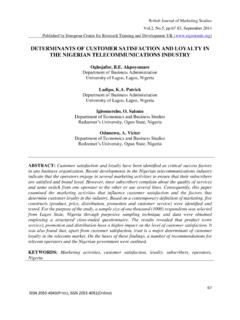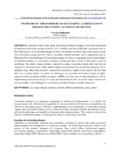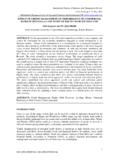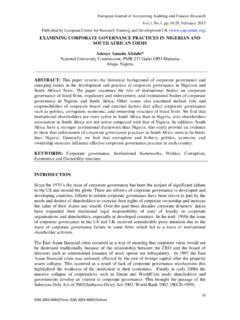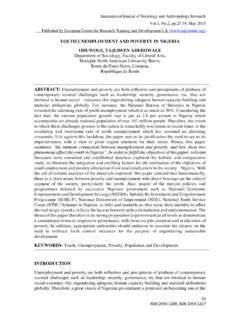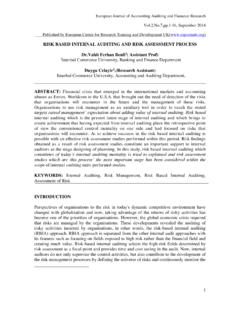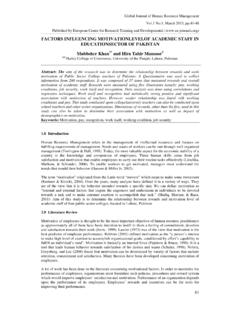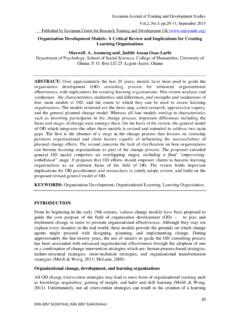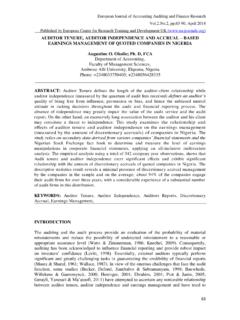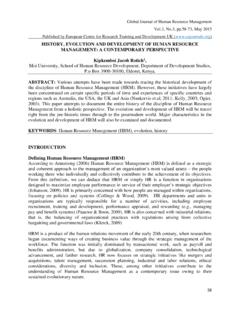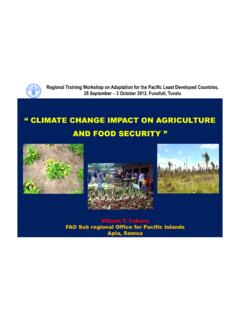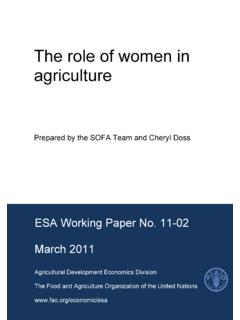Transcription of DETERMINANTS OF HOUSEHOLD FOOD SECURITY AND …
1 European Journal of food Science and Technology , , , July 2015 Published by European Centre for Research Training and Development UK ( ) 30 ISSN 2056-5798(Print), ISSN 2056-5801(online) DETERMINANTS OF HOUSEHOLD food SECURITY AND COPING STRATEGIES: THE CASE OF BULE-HORA DISTRICT, BORANA ZONE, OROMIA, ETHIOPIA Ahmed Mohammed Abdulla Yabelo Pastoral and Dry Land Agriculture Research Center, Yabelo, 85 Yabelo, Ethiopia ABSTRACT: Now a day food SECURITY issues become one of the critical concern and top priority area for developing countries.
2 Having clear picture on food SECURITY status and its major DETERMINANTS helps policy makers and planners to devise new policies that enhance food SECURITY . Hence, this study was conducted to determine the status of food SECURITY in the study area, to identify the major DETERMINANTS of food SECURITY among the rural HOUSEHOLD , and to identify coping strategies employed by different food SECURITY status groups to cope with food insecurity. In order to achieve these objectives biophysical; demographic and socio-economic data were collected from 140 randomly selected households in Bule-hora District of Borana Zone, Oromia Regional State.
3 A two-stage sampling procedure was used to select 5 PAs. A survey was conducted to collect primary data from sample respondent. Secondary data were collected from various sources. The data were analyzed using descriptive statistics such as mean, standard deviation, percentage and frequency distribution. Univariate analysis such as one way ANOVA and Chi-square tests were also employed to describe characteristics of food secure, food insecure without hunger, food insecure with moderate hunger and food insecure with sever hunger categories.
4 The survey result shows that about 23% of sampled farmers were food secure. Ordered logit regression model was fitted to analyze the potential variables affecting HOUSEHOLD food insecurity in the study area. Among 14 explanatory variables included in the logistic model, 6 of them were significant at less than 5% probability level. These are; Cultivate Land Size (LAND SIZE), Livestock holding (TLU) and Improved seed (SEEDUSE), SEX of HOUSEHOLD head, Soil fertility status (SOIL FER) and non-farm income (INCOMEON).
5 The estimated model correctly predicted and different recommendations were made based on the findings of the study. KEYWORDS: food SECURITY , coping mechanism, logit model INTRODUCTION food insecurity has become one of the defining features of rural poverty in Ethiopia, particularly in drought prone areas. The problem of food insecurity in recent years has worsened to the extent that in 2002/03 around 14 million people required food assistance (MARDFSCB, 2005). It has become apparent that due to population growth and land degradation, crop and market failures associated with droughts and other environment factors, as well as low access to assets, the prevalence of poverty and destitution has reached unacceptably high levels in Ethiopia.
6 An estimated of all rural households are thought to be poor, where as European Journal of food Science and Technology , , , July 2015 Published by European Centre for Research Training and Development UK ( ) 31 ISSN 2056-5798(Print), ISSN 2056-5801(online) of the households in the Southern lowlands are estimated to be destitute (MEDAC, 2002; Devereux, Sharp and Yared, 2002; as cited in Yared ,2003). food production and population statistics in Ethiopia are notoriously unreliable, all estimates of national food availability and consumption requirements are guesstimates at best (Devereux and Sussex, 2000).
7 Given this limitation of statistics during the late 1980s, 52% of Ethiopia s population consumed less than the recommended daily allowance of 2,100 kc, Ethiopian agriculture appears to be locked into a downward spiral of low and declining productivity, caused by an adverse combination of agro-climatic, demographic, economic and institutional constraints, trends and shocks. Some observers argue that a Malthusian crisis is developing as rapid population growth (almost 3% per annum) is associated with steadily falling landholdings and per capita food production (Devereux and Sussex, 2000).
8 Between 1960 and 1990 the population doubled from 23 to 48 million, while per capita landholding shrunk from to hectare, and per capita food output collapsed by 41% from 240 to 142 kg (Devereux and Sussex, 2000). Agricultural growth contributes to improve the condition of food SECURITY in the country. There are indications that expected conditions of drought, even the present extension program could have sufficed to bring about a satisfactory level of national food SECURITY .
9 However, as it stands now drought occurs far too often and food SECURITY in all of its dimensions could not be sustained. Irrigation would have to be introduced in a significant way for a sustainable attainment of food SECURITY at the national level. However, food insecurity at the HOUSEHOLD level could still persist despite growth of food and cash crops at national level (MOFED, 2002). Even though food self-sufficiency has remained the stated goal of the Government of Ethiopia, the problem of food insecurity has continued to persist in the country.
10 Many rural households have already lost their means of livelihood due to recurrent drought and crop failures (Ayalneh, 2002). The situation of Borana where Bule-hora district found is not an exception to the food insecurity problem. Therefore, in order to comprehensively address the problem of food insecurity identifying the major DETERMINANTS of food SECURITY becomes crucial. Hence, the aim of this is study is to understand the food SECURITY status, coping strategies and major DETERMINANTS of HOUSEHOLD food SECURITY in the study area.
